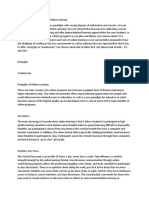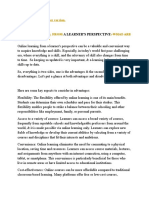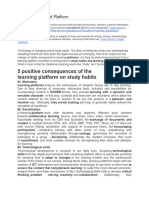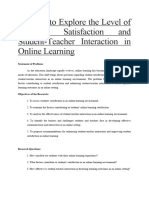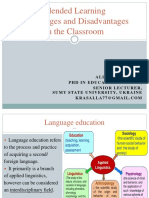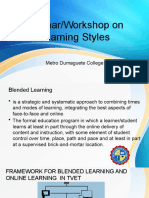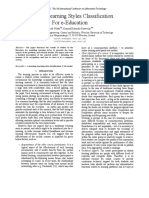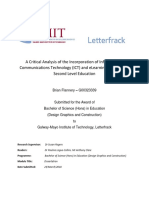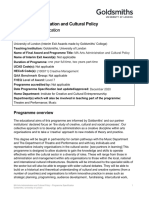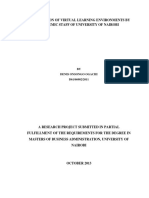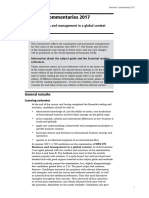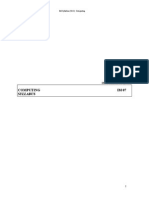English Online Courses A Swot Analysis
English Online Courses A Swot Analysis
Uploaded by
Chitvan KhoslaCopyright:
Available Formats
English Online Courses A Swot Analysis
English Online Courses A Swot Analysis
Uploaded by
Chitvan KhoslaOriginal Title
Copyright
Available Formats
Share this document
Did you find this document useful?
Is this content inappropriate?
Copyright:
Available Formats
English Online Courses A Swot Analysis
English Online Courses A Swot Analysis
Uploaded by
Chitvan KhoslaCopyright:
Available Formats
ENGLISH ONLINE COURSES: A SWOT ANALYSIS
Teacher Isabela-Anda Dragomir, TA Brânduşa-Oana Niculescu PhD, Teacher Oana-
Alida Poşa
The Foreign Language Centre of the Land Forces Headquarters, Sibiu, Romania,
izadragomir@yahoo.com
‘Nicolae Bălcescu’ Land Forces Academy, Sibiu, Romania, branducosma@yahoo.com
The Foreign Language Centre of the Land Forces Headquarters, Sibiu, Romania,
oana_posa@yahoo.com
Abstract: In today’s modern and technology-dominated context, the need for computer-based
instruction has become increasingly employed and has gained more and more ground due to the
numerous advantages and flexible characteristics it entails. Schools, faculties and academic
environments have included this type of e-learning into their curriculum, especially in distance-
learning programs, aiming to bridge the gap between different stages of the educational process.
Access to technology has made it possible for online courses to be implemented and used successfully
in the military educational institutions as well. In the current paper, we set out to offer a pertinent
answer to the debate whether online courses are a better alternative to traditional teaching and
learning approaches, having in view both the advantages and the limitations this type of instruction
has. Our approach aims to sketch a SWOT analysis of online courses in order to prove the
effectiveness of these courses within a foreign language learning program, given the strengths and
weaknesses they have. We have also looked at the way in which educational institutions could take
advantage of the opportunities the external environment offers and exploit them to their advantage,
and last but not the least, on identifying possible threats that could be detrimental to the fruitful
implementation of online learning courses and on discussing possible solutions to overcome them, so
that the ultimate goal of the educational process could be successfully achieved.
Keywords: online courses, traditional learning, learning platforms, technology
1. Introduction classes, class content, tests, homework,
The process of language learning has grades, assessments, and other external
definitely been subjected to many resources such as academic or museum
variations along the years. These have been website links. It is also a social space
brought about by the changes that have where students and teacher can interact
affected society as a whole and which have through threaded discussions or chat” [3].
put their print on all fields of human In more specific terms, the English
activity. Since the 21st century is the learning platforms used in the military
century of a fast-moving world, dominated educational environment have been
and controlled by technology, the changes designed as virtual classes aimed at
in the educational process have become reviewing and reinforcing the content
more and more ubiquitous. The first material (grammar and vocabulary) and the
immersion of technology in the classroom skills and sub-skills practiced and
was done through the use of various developed during the traditional in-class
applications and processes, such as courses.
audio/video tapes, computers, CD-ROM, Our platforms are basically online
or satellite TV. All these brought a breath courses in which the instructors/tutors and
of fresh air to the traditional learning students communicate via computer, the
process and were happily embraced by assignments, tasks, learning activities,
teachers and students alike. The teaching- homework are on screen, communication
learning process took a quantum leap after with the tutor and the other students part of
the discovery of the Internet, which made the virtual group is achieved through
it for a new form of education to appear. specific platform instruments (mail,
This is how e-learning made its way in forum). All these are intercalated within an
school curriculum. It basically refers to instructional program that is based on a
using technology in order to access specific schedule, curriculum, and
learning materials outside the traditional objectives designed according to students’
educational environment. Most often, it linguistic profile and needs. In the
refers to a course or learning program following, we will analyze multiple aspects
delivered online. Thus, we can related to these platforms as educational
unmistakably say that online courses are an tools, referring to strengths, weaknesses,
example of e-learning implementation opportunities and threats, in an attempt to
within the educational process. sketch a brief SWOT analysis.
A basic definition of online courses 2. Strengths and weaknesses
would be that they represent access to We will examine the benefits and
learning materials though the use of the drawbacks from the point of view of the
Internet [1]. A more professional learner, of the tutor and of the institution.
definition would describe online learning 2.1. From the point of view of the
as “a network-enabled transfer of skills and learner
knowledge using a computer” [2]. This The strengths of online courses stem
information transfer and skill development from the advantages offered by this type of
can be done in various ways, one of them system.
being through the use of learning From the perspective of the learner,
platforms. English learning platforms offer a wide
According to www.wikipedia.com, a array of advantages: direct involvement in
learning platform is “an e-learning the learning process, interactivity and
education system based on the web that attractiveness of the content, variety of
models conventional in-person education interaction tools. The learner also benefits
by providing equivalent virtual access to from the opportunity to train at his/her own
pace, independently of other learners, teaching, the course material can be
according to their personal availability structured according to the rhythm of the
(time, location). Immediate tracking students’ own learning strategies and
provides a close monitoring of each methods, learning can take place in short,
learner’s personal progress, opportunities consecutive segments and customized to
for self-assessment and timely feedback. suit both the tutor’s and the learners’
Online platforms also offer the advantage needs [5]. The diversity of attractive and
of personalized instruction, since each and interactive technological tools also
every learner is in direct contact with the stimulates creativity and empowers the
tutor, is individually monitored and by tutor to go beyond the limit of the
accessing the platform he/she belongs to a traditional pen-and-paper methods.
learning environment where tasks and Individual monitoring can offer the tutor a
activities are tailored according to his/her better perspective on every learner’s
needs and as an immediate result of the qualitative and quantitative dimension of
feedback received by the tutor. The content the learning process.
of the platform lessons is organized in the On the other hand, the tutor may feel
form of Units, each available for a limited the need for a direct contact with the
period of time (approximately 2 weeks), learner, which does not actually happen
which offers learners an autonomous self- with online platforms. Moreover, the tutor
management of the learning process. no longer wears the hat of facilitator,
From our experience, we have participant, source of knowledge and is
encountered limitations in what regards the mostly limited to being a ‘conductor’,
learners’ response to using online supervisor, manager of the learning
platforms. software. Methods of teaching are also
Some learners have difficulties in limited, since this type of learning
operating computer-based systems, and encourages written communication in the
managing computer files and online detriment of oral interaction and focuses
learning software can sometimes seem on developing receptive rather than
complex for students with beginner-level productive skills. From the technological
computer skills. Consequently, there is a point of view, one disadvantage is that
certain degree of reticence displayed in some teachers may lack knowledge and
face of new technology. Moreover, experience in managing virtual
learners with low-motivation or bad study interactions, but we consider that this could
habits may fall behind, and, in the absence be overcome by training first teachers to
of the routine structure of the traditional become tutors.
class, some learners may feel lost, isolated 2.3 From the point of view of the
or confused about course activities and institution
deadlines. Another limitation would be the Apart from the human element
lack of direct contact with the tutors which involved in e-learning, there is another
could be considered advantageous since it element that must be taken into
eliminates the degree of subjectivity consideration, and which experiences
inherent to face-to-face interaction. advantages and disadvantages at a wider
2.2 From the point of view of the tutor scale – the institution. It is the greatest
Tutors may find online courses beneficiary from the implementation of
comfortable and convenient since access to these platforms, since an unlimited
technology covers the 4As of e-learning: numbers of learners can be trained with
Any time, Any place, Any pace, Any reduced costs and logistical expenses, and
way[4]. It translates into the fact that e- the needs of the institution can be
learning materials can be developed and customized and adjusted according those
uploaded at the most convenient time for of the recipients of the services it offers.
Thus, the institution is able to open that some learners prefer old-fashioned
additional avenues with which to support methods and are reluctant to embracing
teaching and learning: by providing modern technologized instruction. This
distance learning programs and by shortcoming could be overcome by
blending traditional and virtual teaching avoiding the overuse of online platforms
due to the combination between face-to- and relying on them exclusively, and by
face interaction and technology. Owing to effectively embedding them into the
platform courses, training can also be traditional but still efficient traditional
tailored according to pre-defined skills and learning, as part of broader and more
teaching goals and the feedback is precise, comprehensive programs.
immediate, automated, and therefore 4. Conclusions
accurate. E-learning is a critical portion of
On the downside, implementing modern instruction that ensures success for
platform courses entails financial the learner, the tutor and the institution
investments (hardware and software, alike. From our brief SWOT analysis, we
personnel training) and a change in the can conclude that there are specific
management conception that should be elements to be considered when analyzing
adapted and more oriented towards online online courses as compared to traditional
instruction. At the same time, the employer learning: maintainability, compatibility,
has no control over the motivation, usability, flexibility, modularity, and
involvement, and learners’ course accessibility. Both types of instructions
management. have these characteristics and it is up to the
3. Opportunities and threats institution and ultimately to the teacher to
Online learning is booming and select the best suited one. We advocate the
becoming more and more common due to practice of blended learning in the
the continuous developments and advances discipline of English as a foreign language,
in the field of technology. E-learning can since we consider that students, tutors and
be done on laptops, tablets or even the institution altogether can greatly
smartphones, so it has become a mobile benefit from a successful combination of
and dynamic method of continuous the two [6]. Blended learning goes beyond
learning. It has wiped out geographical technology-based instruction of the type
borders and has become a tool that one-on-one computers or state-of-the-art
contributes to the spread of globalization, technology. It ultimately involves making
since web-delivered content is easily use of online learning platforms so as to
modifiable, and translatable for different empower students to take control of their
cultural environments. own learning process, and to personalize
There is still a subtle competition and individualize instruction in a way that
between traditional learning and e- it affords the students’ control over the
learning, so the biggest threat from this time, place and content of the learning.
perspective could be attributed to the fact
References
[1] Angela D. Benson, Using Online Learning to Meet Workforce Demand: A Case Study of
Stakeholder Influence, in Quarterly Review of Distance Education, Vol. 3, No. 4, pp. 443-
452, 2002.
[2] www.successdegrees.com/definition-of-online-courses.html
[3] www.wikipedia.com
[4] www.mnsu.edu/cetl/teachingwithtechnology/tech_resources_pdf
[5] Keenan A. Pituch, Yao-kuei Lee, The influence of system characteristics on e-learning
use, in Computer and Education, Vol. 47, No. 2, pp. 222-244, September, 2006. Retrieved
from http://www.pgce.soton.ac.uk
[6] Charles D. Dziuban, Joel L. Hartman, Patsy D. Moskal, Blended learning, in ECAR
Research Bulletin, Vol. 2004, Issue 7, pp. 2-11, March 30, 2004.
You might also like
- Design and Implementation of A Web Based System For Distance LearningDocument17 pagesDesign and Implementation of A Web Based System For Distance Learningsanusi bello bakura100% (5)
- Module No. 4: Flexible Learning EnvironmentDocument14 pagesModule No. 4: Flexible Learning EnvironmentMika Virtudazo100% (2)
- IR3140 VleDocument96 pagesIR3140 VleUci IslamabadNo ratings yet
- DESIGN AND IMPLEMENTATION OF A VIRTUAL E-LEARNING SYSTEM (A Case Study of Lagos State University)Document11 pagesDESIGN AND IMPLEMENTATION OF A VIRTUAL E-LEARNING SYSTEM (A Case Study of Lagos State University)Godwin Oma100% (1)
- CHAPTER 1 E-LearningDocument5 pagesCHAPTER 1 E-Learningmylenwzy7No ratings yet
- Strengths and Weaknesses of Online LearningDocument6 pagesStrengths and Weaknesses of Online LearningAllan TomasNo ratings yet
- Chapter One RevisedDocument6 pagesChapter One RevisedmeinjehlNo ratings yet
- PROPOSALDocument5 pagesPROPOSALoluwatomisinfidelisNo ratings yet
- Lesson 6 Blended Learning DesignDocument8 pagesLesson 6 Blended Learning DesignLou TraveroNo ratings yet
- Students Perceptions On Online EducationDocument4 pagesStudents Perceptions On Online EducationManisha AgarwalNo ratings yet
- The Effect of Online Educational Learning PlatformDocument11 pagesThe Effect of Online Educational Learning PlatformJaylou M. TaboriteNo ratings yet
- Article On Online Learning From A Learner's Perspective v2Document5 pagesArticle On Online Learning From A Learner's Perspective v2KRISHNA KUMARNo ratings yet
- Emergence & Significance of Online Education Over Classroom LearningDocument12 pagesEmergence & Significance of Online Education Over Classroom LearningParveenNo ratings yet
- Distance LearningDocument1 pageDistance LearningHaellariieNo ratings yet
- Literature Review On Project WorkDocument3 pagesLiterature Review On Project WorkAlexander NyarkoNo ratings yet
- Activity For Distance LearningDocument2 pagesActivity For Distance LearningIRENE GARDONNo ratings yet
- What Is Educational PlatformDocument5 pagesWhat Is Educational PlatformRoselda Icaro - BacsalNo ratings yet
- Evaluating The Proficiency of Science Educators in Developing and Executing Online Instruction A Case Study of Secondary Schools in UgandaDocument24 pagesEvaluating The Proficiency of Science Educators in Developing and Executing Online Instruction A Case Study of Secondary Schools in UgandaKIU PUBLICATION AND EXTENSIONNo ratings yet
- Artikel Jurnal 85%Document14 pagesArtikel Jurnal 85%Widya Nur AfiatiNo ratings yet
- Virtual English Course Language Center University of IbagueDocument5 pagesVirtual English Course Language Center University of IbagueCarlos Hernando OrtizNo ratings yet
- Descriptive Swot Analysis About Online LearningDocument10 pagesDescriptive Swot Analysis About Online LearningMadhusudan MNo ratings yet
- Why Is Online Teaching Important?Document6 pagesWhy Is Online Teaching Important?Simon McIntyreNo ratings yet
- Fall 2023 - EDUA630 - 3 - BC220414139Document21 pagesFall 2023 - EDUA630 - 3 - BC220414139Muhammad UsmanNo ratings yet
- Learning FL at A DistanceDocument19 pagesLearning FL at A DistanceElysio SoaresNo ratings yet
- Unit 10Document24 pagesUnit 10Julian CaballeroNo ratings yet
- Educational Tech (Article Review) - Faraazean - A19hp3016Document3 pagesEducational Tech (Article Review) - Faraazean - A19hp3016fara azeanNo ratings yet
- Teaching Zulu Online For L2 Learners: Possibilities and ProblemsDocument4 pagesTeaching Zulu Online For L2 Learners: Possibilities and ProblemstetirichieNo ratings yet
- Assignment Hmef5083 RosazaliDocument16 pagesAssignment Hmef5083 Rosazalirimr1980No ratings yet
- Fall 2023 - EDUA630 - 3 - BC220414139Document23 pagesFall 2023 - EDUA630 - 3 - BC220414139Muhammad UsmanNo ratings yet
- Universidad Gerardo BarriosDocument9 pagesUniversidad Gerardo BarriosAlex GarayNo ratings yet
- Blended LearningDocument9 pagesBlended LearningAlex GarayNo ratings yet
- Education Online The Latest State of ResearchDocument54 pagesEducation Online The Latest State of ResearchHalina Ostańkowicz-Bazan100% (1)
- Barriers of Blended LearningDocument7 pagesBarriers of Blended LearningSamreenNo ratings yet
- Online Assignment TechnologyDocument13 pagesOnline Assignment TechnologySneha RajeevNo ratings yet
- Online Assignment TechnologyDocument13 pagesOnline Assignment TechnologySneha RajeevNo ratings yet
- Fall 2023 - TPTG620 - 3 - BC220414139Document25 pagesFall 2023 - TPTG620 - 3 - BC220414139Muhammad UsmanNo ratings yet
- Eds3701 Assignment 2 2023Document5 pagesEds3701 Assignment 2 2023mangalamacdonaldNo ratings yet
- Some Universities Offer Online Courses As An Alternative To Classes Delivered On CampusDocument8 pagesSome Universities Offer Online Courses As An Alternative To Classes Delivered On CampusÁnh LãNo ratings yet
- The Concepts and Methods of Distance Education Code# 0842 Unit# 1 Introduction To Distance EducationDocument24 pagesThe Concepts and Methods of Distance Education Code# 0842 Unit# 1 Introduction To Distance EducationSyeda HadiaNo ratings yet
- Fall 2023 - TPTG620 - 3 - BC220414139Document26 pagesFall 2023 - TPTG620 - 3 - BC220414139Muhammad UsmanNo ratings yet
- Final 50Document48 pagesFinal 50Sri KamalNo ratings yet
- 6 Ka PDFDocument22 pages6 Ka PDFsuraj jaiswalNo ratings yet
- Chapter 2 (PR1)Document2 pagesChapter 2 (PR1)ANGELA ADRIOSULANo ratings yet
- Gracelyn ResearchpaperDocument30 pagesGracelyn ResearchpapercrisdayNo ratings yet
- Sample First DraftDocument60 pagesSample First DraftNoor MuhammadNo ratings yet
- E LearningDocument19 pagesE LearningDharshiny GhayathriNo ratings yet
- Using Blended Learning To Accommodate Different Learning StylesDocument5 pagesUsing Blended Learning To Accommodate Different Learning StylesAndy PierceNo ratings yet
- Covid Book ToolkitDocument52 pagesCovid Book ToolkitvibhaNo ratings yet
- E Learning Stanje I PerspektiveDocument6 pagesE Learning Stanje I PerspektiveLazoRoljićNo ratings yet
- Blended LearningDocument25 pagesBlended LearningGrace YenNo ratings yet
- University of Huddersfield RepositoryDocument8 pagesUniversity of Huddersfield Repositoryإمحمد السنوسي القزيريNo ratings yet
- Seminar/Workshop On Learning Styles: Metro Dumaguete CollegeDocument15 pagesSeminar/Workshop On Learning Styles: Metro Dumaguete CollegeEm Boquiren CarreonNo ratings yet
- Review of Educational Technology Closing The Gap Between Modern Technology and The College Engineering ClassroomDocument10 pagesReview of Educational Technology Closing The Gap Between Modern Technology and The College Engineering ClassroomOdudu Ebu-nkamaodoNo ratings yet
- Students Learning Styles Classification For E-Education: Marek Woda, Konrad Kubacki-GorweckiDocument6 pagesStudents Learning Styles Classification For E-Education: Marek Woda, Konrad Kubacki-GorweckiKartika Nurul FahmiNo ratings yet
- Technology and Its Use in Education-Present Roles and Future ProspectsDocument19 pagesTechnology and Its Use in Education-Present Roles and Future ProspectsmockeroNo ratings yet
- Diverse Learning Modes in EducationDocument9 pagesDiverse Learning Modes in EducationVen PortesNo ratings yet
- Distance Learning Historical PaperDocument11 pagesDistance Learning Historical PaperTerry PriahNo ratings yet
- Study Tips NewsletterDocument26 pagesStudy Tips Newsletterphucbui2008ptNo ratings yet
- Factors Extraction of Effective Teaching-Learning in Online and Conventional ClassroomsDocument6 pagesFactors Extraction of Effective Teaching-Learning in Online and Conventional ClassroomsNicollesNo ratings yet
- Artikel Fisling B IngDocument3 pagesArtikel Fisling B IngDian KhairaniNo ratings yet
- Unlock Your Child's Genius - The Secret Weapon of Online TutoringFrom EverandUnlock Your Child's Genius - The Secret Weapon of Online TutoringNo ratings yet
- Online & Flexible Learning: Student Guide 2022-2023Document43 pagesOnline & Flexible Learning: Student Guide 2022-2023Sajid MehmoodNo ratings yet
- Tamayo - Techno Plan (Revised)Document5 pagesTamayo - Techno Plan (Revised)Rose BrillantesNo ratings yet
- Flannery-Brian-G00323339-Dissertation PaperDocument29 pagesFlannery-Brian-G00323339-Dissertation Paperapi-381307435No ratings yet
- Nescol Care With Esol Course BrochureDocument3 pagesNescol Care With Esol Course BrochureMatías ArgüelloNo ratings yet
- Full Paper IMPACTS OF VIRTUAL CLASSROOM LEARNING ON STUDENTS' OF NIGERIANDocument16 pagesFull Paper IMPACTS OF VIRTUAL CLASSROOM LEARNING ON STUDENTS' OF NIGERIANAderemi OmotayoNo ratings yet
- Free Youth Work Courses BrisbaneDocument5 pagesFree Youth Work Courses Brisbanepenebef0kyh3100% (2)
- (Research Paper) The Introduction of Blackboard at Halmstad University - Consolidation & Institutionalization - Rasmey HeangDocument31 pages(Research Paper) The Introduction of Blackboard at Halmstad University - Consolidation & Institutionalization - Rasmey HeangRasmey HeangNo ratings yet
- University of Southeastern Philippines: Course Syllabus in It 121 - TechnopreneurshipDocument8 pagesUniversity of Southeastern Philippines: Course Syllabus in It 121 - TechnopreneurshipArch Cenas100% (1)
- Group 2 (Action Research FS2)Document28 pagesGroup 2 (Action Research FS2)Lovely Rose Dungan TiongsonNo ratings yet
- Maryknoll College of Panabo, Inc.: Prk. Atis, Nat'l Highway, Brgy. Sto. Niño, Panabo CityDocument80 pagesMaryknoll College of Panabo, Inc.: Prk. Atis, Nat'l Highway, Brgy. Sto. Niño, Panabo CityPearl OroscoNo ratings yet
- Ma Arts Administration and Cultural PolicyDocument16 pagesMa Arts Administration and Cultural PolicyKevin MaulidianNo ratings yet
- Learning Episodes 1 6 - FS2Document51 pagesLearning Episodes 1 6 - FS2Jessica EdilloNo ratings yet
- HolonIQ 2021 Global Learning Landscape HandbookDocument70 pagesHolonIQ 2021 Global Learning Landscape HandbookQuang TranNo ratings yet
- EDUCATION TECHNOLOGY INTEGRATION IN TEACHING AssignmentDocument10 pagesEDUCATION TECHNOLOGY INTEGRATION IN TEACHING AssignmentLeela Subramaniam LeelaNo ratings yet
- Ogachi - The Adoption of Virtual Learning Environments by Academic StaffDocument69 pagesOgachi - The Adoption of Virtual Learning Environments by Academic Stafftahani emhmedNo ratings yet
- Tata Steel E-Learning Capability Development: A Project Report ONDocument33 pagesTata Steel E-Learning Capability Development: A Project Report ONnarendraNo ratings yet
- AI Enabled Adaptive Learning Systems A Sys - 2021 - Computers and Education ArDocument12 pagesAI Enabled Adaptive Learning Systems A Sys - 2021 - Computers and Education AryaestaNo ratings yet
- Aben PublicationDocument12 pagesAben PublicationTempler OfumNo ratings yet
- Business Management 1178 2017 With CommentaryDocument19 pagesBusiness Management 1178 2017 With Commentarylosika.mosupiNo ratings yet
- Ets 15 3 PDFDocument343 pagesEts 15 3 PDFEncep Iman Hadi SunaryaNo ratings yet
- Online Problem-Based Learning (PBL) During Coronavirus Pandemic: Trial at The Libyan International Medical UniversityDocument7 pagesOnline Problem-Based Learning (PBL) During Coronavirus Pandemic: Trial at The Libyan International Medical UniversityIJAR JOURNALNo ratings yet
- 01 Types of Online Services Zain KhanDocument2 pages01 Types of Online Services Zain Khanapi-673311932No ratings yet
- Pedagogical View of E-Learning ActivitiesDocument5 pagesPedagogical View of E-Learning ActivitiesResearch ParkNo ratings yet
- Syllabus AS A Road MAP Quipment NeededDocument4 pagesSyllabus AS A Road MAP Quipment NeededNasufoski AlbertNo ratings yet
- Computer Intermediate SyllabusDocument15 pagesComputer Intermediate SyllabussimonrapaNo ratings yet
- Build and Deploy Your Own Learning Management Systems Using Moodle 2.x On CentOS-6 Server v1.0Document11 pagesBuild and Deploy Your Own Learning Management Systems Using Moodle 2.x On CentOS-6 Server v1.0Kefa RabahNo ratings yet
- Level 7 Diploma in Education Management and Leadership - Delivered Online by LSBR, UKDocument19 pagesLevel 7 Diploma in Education Management and Leadership - Delivered Online by LSBR, UKLSBRNo ratings yet
- SCIENCE 11 Course Guide (Aug 2018)Document8 pagesSCIENCE 11 Course Guide (Aug 2018)Richelda Mei ReodicaNo ratings yet
- Online Learning Program DevelopmentDocument6 pagesOnline Learning Program DevelopmentBedilu AssefaNo ratings yet





